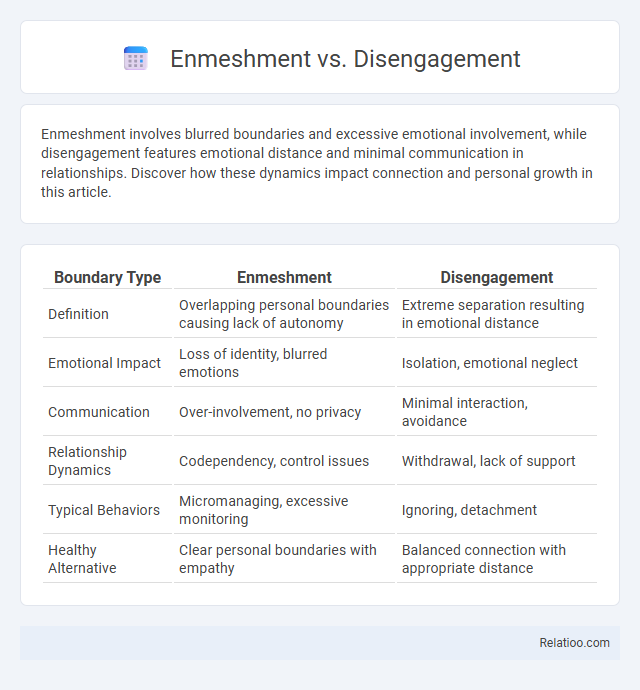Enmeshment involves blurred boundaries and excessive emotional involvement, while disengagement features emotional distance and minimal communication in relationships. Discover how these dynamics impact connection and personal growth in this article.
Table of Comparison
| Boundary Type | Enmeshment | Disengagement |
|---|---|---|
| Definition | Overlapping personal boundaries causing lack of autonomy | Extreme separation resulting in emotional distance |
| Emotional Impact | Loss of identity, blurred emotions | Isolation, emotional neglect |
| Communication | Over-involvement, no privacy | Minimal interaction, avoidance |
| Relationship Dynamics | Codependency, control issues | Withdrawal, lack of support |
| Typical Behaviors | Micromanaging, excessive monitoring | Ignoring, detachment |
| Healthy Alternative | Clear personal boundaries with empathy | Balanced connection with appropriate distance |
Introduction to Enmeshment and Disengagement
Enmeshment describes relationships where personal boundaries are blurred, causing excessive emotional involvement and a lack of individual autonomy. Disengagement, in contrast, involves overly rigid boundaries, leading to emotional distance and limited support among family members. Understanding these dynamics is crucial for recognizing unhealthy relational patterns and promoting balanced interpersonal connections.
Defining Enmeshment in Relationships
Enmeshment in relationships occurs when personal boundaries become blurred, causing an excessive emotional dependence between individuals that hinders autonomy and healthy individuality. Unlike disengagement, where emotional distance and lack of connection dominate, enmeshment traps you in a web of over-involvement and loss of self-identity. Understanding these dynamics helps you recognize when a relationship shifts from supportive to enmeshed, prompting necessary boundaries for emotional well-being.
Understanding Disengagement Dynamics
Disengagement dynamics involve emotional distance and lack of connection between family members, leading to isolation and difficulties in effective communication. Understanding disengagement helps you recognize patterns where individuals avoid sharing feelings or avoid intimate interactions, causing relational breakdowns. Addressing disengagement requires fostering open communication and emotional availability to rebuild trust and strengthen bonds.
Key Differences Between Enmeshment and Disengagement
Enmeshment involves overly close relationships where personal boundaries are blurred, causing individuals to struggle with independence, while disengagement is characterized by emotional distance and lack of connection, leading to isolation. Key differences include emotional intensity and dependence--enmeshment fosters excessive dependence and loss of individuality, whereas disengagement results in emotional withdrawal and detachment. Understanding these dynamics can help Your relationships become healthier by recognizing when boundaries are either too rigid or too diffuse.
Psychological Impact of Enmeshment
Enmeshment creates blurred boundaries in relationships, leading to a loss of personal identity and difficulty establishing independence, which can cause significant emotional distress and confusion in your sense of self. Disengagement, characterized by emotional distance and lack of support, often results in feelings of isolation and neglect, intensifying vulnerability to anxiety and depression. Understanding these contrasting dynamics helps identify the psychological impact of enmeshment, promoting healthier relationship patterns and emotional well-being.
Emotional Consequences of Disengagement
Disengagement in relationships often leads to emotional numbness, feelings of isolation, and difficulty in forming close connections due to a lack of intimacy and support. Unlike enmeshment, which can cause emotional over-dependence and blurred boundaries, disengagement fosters emotional withdrawal and detachment. Your emotional well-being may suffer from increased loneliness and unresolved conflicts when disengagement dominates interpersonal dynamics.
Causes and Contributing Factors
Enmeshment often arises from overprotective parenting and blurred boundaries, leading to lack of individual autonomy. Disengagement stems from emotional neglect, inconsistent communication, and parental detachment, causing isolation and poor interpersonal connection. These dysfunctional family dynamics are primarily influenced by unresolved trauma, low emotional intelligence, and ineffective conflict resolution strategies.
Signs and Symptoms to Recognize
Recognizing signs and symptoms of enmeshment, disengagement, and balanced boundaries is crucial for healthy relationships. Enmeshment often manifests as blurred personal boundaries, excessive emotional dependence, and difficulty asserting individuality, while disengagement is characterized by emotional distance, lack of communication, and avoidance of intimacy. Your ability to identify these patterns can help foster healthier connections by promoting emotional autonomy and appropriate closeness.
Strategies for Achieving Healthy Boundaries
Strategies for achieving healthy boundaries involve recognizing patterns of enmeshment and disengagement to create balanced relationships. You can establish clear emotional limits by communicating openly, practicing self-awareness, and respecting personal space while fostering connection. Implementing consistent boundaries helps prevent codependency and isolation, promoting both individual autonomy and healthy interdependence.
Seeking Support and Professional Help
Seeking support in enmeshment involves recognizing blurred boundaries and prioritizing individual autonomy while engaging in therapeutic interventions like family therapy or counseling. In disengagement, support focuses on rebuilding healthy connections and promoting emotional availability through structured communication skills training and attachment-based therapy. Professional help is essential to tailor strategies that clarify relationship dynamics, enhance emotional regulation, and foster balanced interpersonal involvement.

Infographic: Enmeshment vs Disengagement
 relatioo.com
relatioo.com